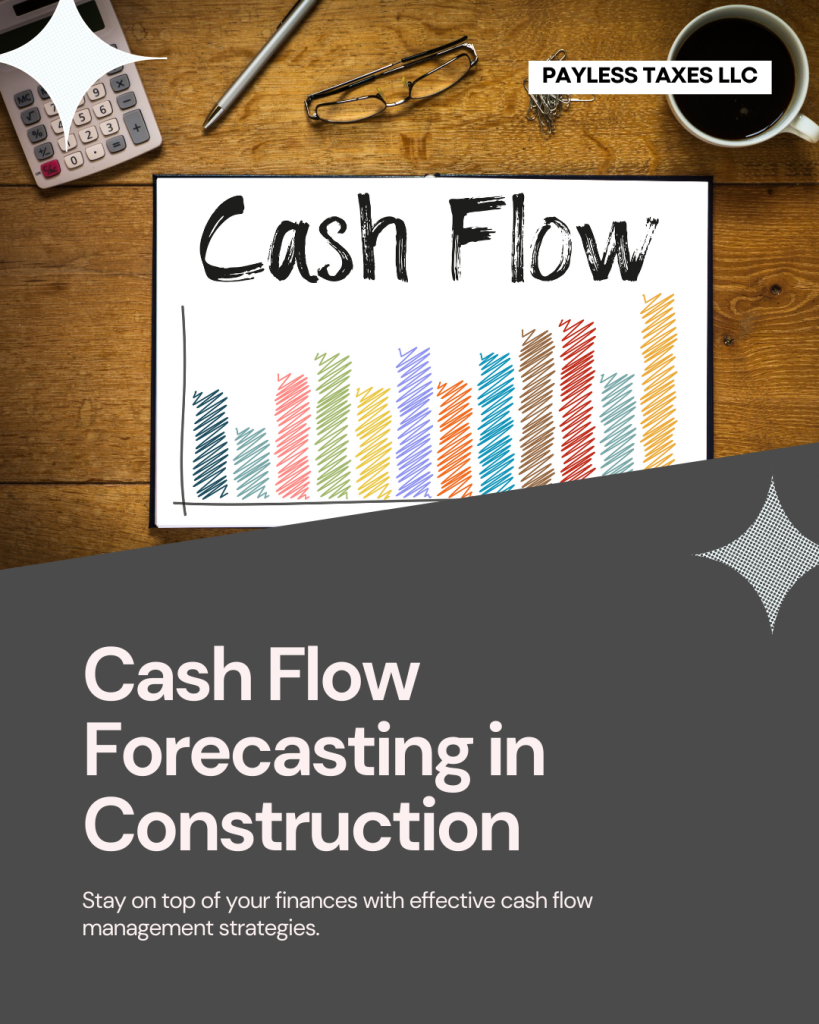
In commercial construction, profit doesn’t equal cash.
You can be running a profitable business, winning contracts, and hitting milestones—but still find yourself short on cash when payroll is due or your next big material order hits.
Why? Because cash flow in construction is a different animal—and without a reliable forecasting system in place, it’s easy to get caught off guard.
In this post, we’ll show you:
- Why cash crunches are so common in construction
- What cash flow forecasting really looks like
- Five proven strategies to manage cash flow and stay ahead
Let’s get into it.
🏗️ Why Cash Crunches Are So Common in Construction
Construction has one of the most complex cash cycles of any industry. Here’s what makes it challenging:
- Upfront costs: Crews, materials, equipment, and permits are often paid for well before any invoice goes out.
- Milestone billing: Invoices are tied to completed work—not work in progress.
- Retainage: A percentage of every invoice (typically 5–10%) is withheld until the end of the project.
- Slow payments: Even once you bill, payments can take 30, 60, or even 90 days to arrive.
Meanwhile, expenses like payroll, insurance, and overhead don’t wait.
Without proactive planning, this creates a serious risk of falling into a cash crunch, even on otherwise profitable jobs.
🔍 What Is Cash Flow Forecasting in Construction?
Cash flow forecasting is the process of predicting the timing and amount of cash inflows and outflows over a specific period—typically 30, 60, or 90 days.
It involves:
- Mapping out upcoming receivables from client invoices, retainage, and change orders
- Projecting upcoming expenses like labor, materials, equipment, and subcontractor payments
- Planning for timing gaps between when you incur costs and when you get paid
Done right, forecasting gives you a real-time picture of your financial runway—so you can make decisions before things get tight.
💡 5 Strategies to Improve Cash Flow Forecasting
Here’s how to build a smarter, more resilient cash flow forecast for your construction business:
1. 📅 Build a Job-Level Cash Flow Calendar
Start with a detailed calendar for each active job. Include:
- Billing milestones or % complete estimates
- Expected payment timing, based on historical client behavior
- Upcoming expenses, such as material orders, payroll periods, and subcontractor draws
A visual map helps you clearly identify when cash will go out vs. come in—and which jobs might leave you exposed.
Even a simple weekly spreadsheet can offer huge insight.
2. 🧾 Align Forecasts with Real Payment Behavior
Don’t assume clients will pay on time. Forecast based on reality, not the ideal.
- Use actual payment history (from AR aging reports) to estimate when cash will hit your account
- Treat retainage separately—it should only appear in your forecast when it’s truly due
- Don’t count pending change orders until they’re approved and billed
The more accurately you can predict real cash receipts, the more trustworthy your forecast becomes.
3. 💻 Use Tools That Sync Forecasting with Real-Time Data
It’s nearly impossible to manage cash flow effectively if your data is siloed or outdated.
Look for construction accounting tools that allow you to:
- See actual job costs vs. projected
- Track committed costs (what’s been ordered but not yet spent)
- Monitor billing progress vs. work performed
Popular tools include:
- Sage 300 CRE / Intacct
- Procore + QuickBooks integrations
- Viewpoint Vista
- Buildertrend, Knowify, or CoConstruct
The key is visibility—real-time numbers drive proactive decisions.
4. 🛑 Track and Correct Underbilling
Underbilling happens when your job progress outpaces your invoices. It’s common—and dangerous.
It means:
- You’ve already spent money on labor and materials
- But haven’t billed the client yet
- And may not be forecasting the cash shortfall it creates
To fix this:
- Review Work-In-Progress (WIP) reports regularly
- Compare % of work completed with % billed
- Flag and correct underbilling early—before it strains your cash position
5. 🧰 Build Contingency Plans Into the Forecast
Even the best forecast won’t prevent surprises. So plan for them.
- Maintain a cash reserve or working line of credit to handle short-term gaps
- Negotiate terms with vendors and subs that align with your billing cycle
- Categorize expenses into “critical” and “flexible” so you know what can be delayed if needed
This kind of financial playbook helps you stay calm and in control—even when something unexpected hits your schedule or your receivables.
✅ Final Thoughts: Forecasting is the Antidote to Uncertainty
Construction companies don’t get paid like most businesses. You’re floating costs upfront, billing in chunks, and waiting to get paid—all while juggling multiple jobs at once.
That’s why cash flow forecasting isn’t just helpful—it’s critical.
When you forecast accurately, you can:
- Stay ahead of shortfalls
- Make confident hiring or investment decisions
- Avoid crisis-mode reactions
- Focus on running projects—not chasing checks
📣 Need Help Building a Smarter Forecast?
Whether you’re using Procore, QuickBooks, Sage, or just spreadsheets—we help construction firms design cash flow forecasting systems that work in the real world.
👉 Let’s talk. We’ll walk through your current setup and show you how to get clear, job-level visibility into your cash position.
Your next project shouldn’t come with a cash flow surprise.
